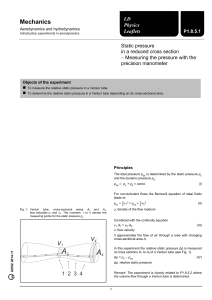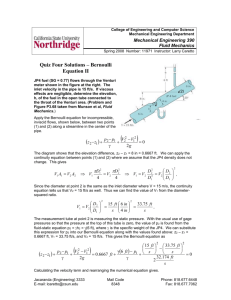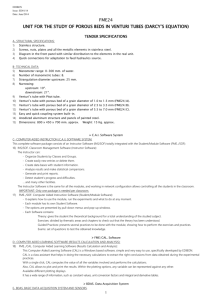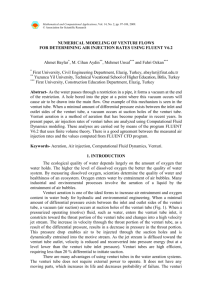P1.8.5.2 Determining the volume flow with a Venturi tube
advertisement
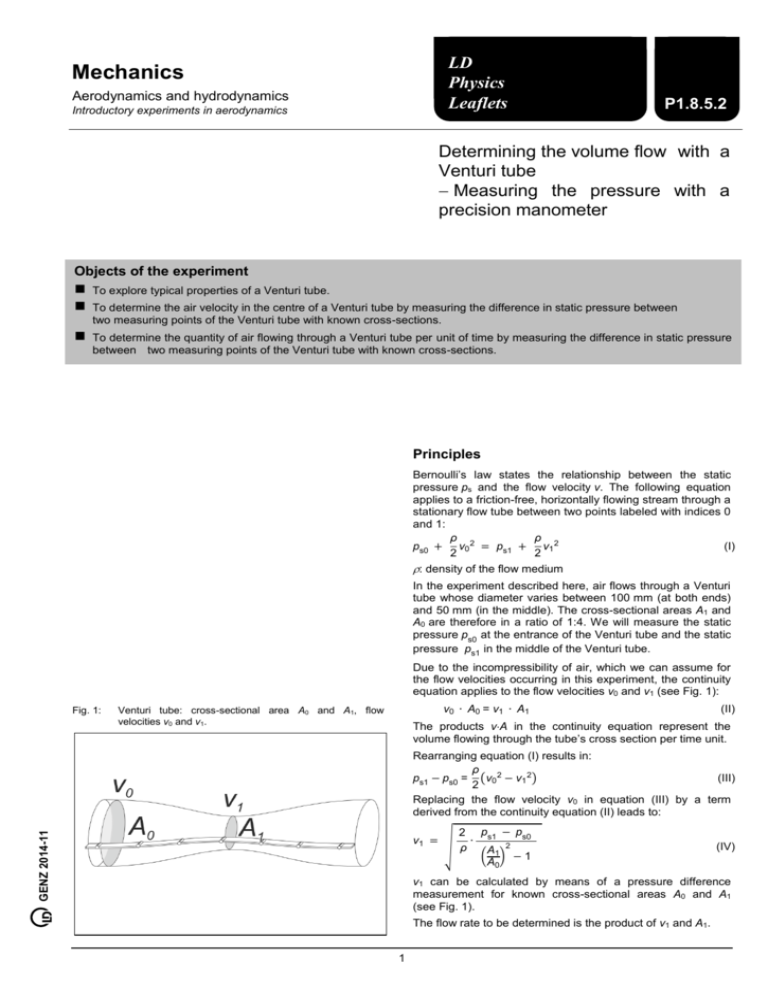
LD Physics Leaflets Mechanics Aerodynamics and hydrodynamics Introductory experiments in aerodynamics P1.8.5.2 Determining the volume flow with a Venturi tube Measuring the pressure with a precision manometer Objects of the experiment To explore typical properties of a Venturi tube. To determine the air velocity in the centre of a Venturi tube by measuring the difference in static pressure between two measuring points of the Venturi tube with known cross-sections. To determine the quantity of air flowing through a Venturi tube per unit of time by measuring the difference in static pressure between two measuring points of the Venturi tube with known cross-sections. Principles Bernoulli’s law states the relationship between the static pressure ps and the flow velocity v. The following equation applies to a friction-free, horizontally flowing stream through a stationary flow tube between two points labeled with indices 0 and 1: ρ ρ ps0 + v0 2 = ps1 + v1 2 (I) 2 2 : density of the flow medium In the experiment described here, air flows through a Venturi tube whose diameter varies between 100 mm (at both ends) and 50 mm (in the middle). The cross-sectional areas A1 and A0 are therefore in a ratio of 1:4. We will measure the static pressure ps0 at the entrance of the Venturi tube and the static pressure ps1 in the middle of the Venturi tube. Due to the incompressibility of air, which we can assume for the flow velocities occurring in this experiment, the continuity equation applies to the flow velocities v0 and v1 (see Fig. 1): Fig. 1: v0 ∙ A0 = v1 ∙ A1 Venturi tube: cross-sectional area A0 and A1, flow velocities v0 and v1. (II) The products vA in the continuity equation represent the volume flowing through the tube’s cross section per time unit. GENZ 2014-11 Rearranging equation (I) results in: ρ ps1 − ps0 = (v0 2 − v1 2 ) (III) 2 Replacing the flow velocity v0 in equation (III) by a term derived from the continuity equation (II) leads to: v1 = 2 ps1 − ps0 ∙ √ ρ A 2 ( 1) − 1 A0 (IV) v1 can be calculated by means of a pressure difference measurement for known cross-sectional areas A0 and A1 (see Fig. 1). The flow rate to be determined is the product of v1 and A1. 1 P1.8.5.2 LD Physics Leaflets Setup Apparatus 1 1 1 2 1 1 1 Equip the suction and pressure fan with the small nozzle (100 mm) and the Venturi tube on the pressure side. Position the pressure fan horizontally on the base as shown in Fig. 2. Additionally, support the Venturi tube using the stand base, stand rod and Leybold multiclamp. Do not overtighten the screw of the Leybold multiclamp. Suction and pressure fan ............................... 373 041 Venturi tube with multimanoscope ................. 373 091 Precision manometer ..................................... 373 10 Stand base, V-shaped, small ......................... 300 02 Stand rod, 25 cm, 12 mm Ø........................... 300 41 Stand rod, 47 cm, 12 mm Ø........................... 300 42 Leybold multiclamp ........................................ 301 01 – Optional: 1 CASSY Lab 2 ................................................ 524 220 Additionally required: 1 PC with Windows XP or higher – – Align the precision manometer exactly horizontal. If needed, refill the reservoir for manometer fluid. Connect the hose of the precision manometer to the precision manometer’s tube attachment nipple for highpressure (left). Connect the other end of the hose to the hose nipple and plug it into measuring point 0 of the Venturi tube (see Fig. 2Fig. 2). Connect the hose of the precision manometer to the precision manometer’s tube attachment nipple for lowpressure (right). Connect the other end of the hose to the hose nipple and plug it into measuring point 1 of the Venturi tube (see Fig. 2). Safety notes Mind the safety notes in the instruction sheet of the suction and pressure fan. Before removing the protective grid or the nozzle: Pull out the mains plug and wait for at least 30 seconds until the suction and pressure fan comes to a complete stop. Fig. 2: Experimental setup with the precision manometer. 2 P1.8.5.2 LD Physics Leaflets Carrying out the experiment Remark: Repeat one measurement several times for estimating measuring errors. a) Measuring without CASSY Lab 2 b) Measuring with CASSY Lab 2 – – If not yet installed, install the software CASSY Lab 2 and open the software. – Set the suction and pressure fan to its minimum speed (i.e. left limit position of fan control) and only then switch it on. – Slowly increase the speed of the suction and pressure fan until the static pressure difference Δp (= ps1 - ps0) between measuring points 0 and 1 reaches approx. -140 Pa. Remark: Since the static pressure ps decreases from measuring point 0 to 1 the static pressure difference Δp is negative. – Read off the static pressure difference Δp. – Load the settings in CASSY Lab 2 and type the pressure value in table “Δp(n) [manu.]”. Set the suction and pressure fan to its minimum speed (i.e. left limit position of fan control) and only then switch it on. – Slowly increase the speed of the suction and pressure fan until the static pressure difference Δp (= ps1 - ps0) between measuring points 0 and 1 reaches approx. -140 Pa. Remark: Since the static pressure ps decreases from measuring point 0 to 1 the static pressure difference Δp is negative. – Read off the static pressure difference Δp and note the pressure value in a table. 3 P1.8.5.2 LD Physics Leaflets Measuring example Evaluation and results p = ps1 – ps0 = -1.4 hPa = -140 Pa With the measuring results, equation (IV) and the density ρ of the flow medium air kg ρ = 1.2 3 A1 19.6 cm² = = 0.25 A0 78.5 cm² Tab 1: n m we obtain the flow velocity at measuring point 1: Five measurements of the difference in static pressure Δp between measuring points 0 and 1 of the Venturi tube (see Fig. 1) at constant overall wind speed. 1 2 3 4 v1 = 2 ps1 − ps0 ∙ √ ρ A 2 ( 1) − 1 A0 =√ −140 Pa m ∙ = 15.8 kg (0.25)2 − 1 s 1.2 3 m 2 5 With the measuring result ∆p Pa -135 ̅̅̅̅ ∆p Pa -143 -147 -136 -141 A1 = (0.025) m = 1.9610 m 2 2 -3 2 we obtain the flow rate: -140 v1 ∙ A1 = 0.031 m3 l = 31 s s © by LD DIDACTIC GmbH · Leyboldstr. 1 · D-50354 Huerth · Phone: +49-2233-604-0 · Fax: +49-2233-604-222 · E-mail: info@ld-didactic.de www.ld-didactic.com Technical alterations reserved
